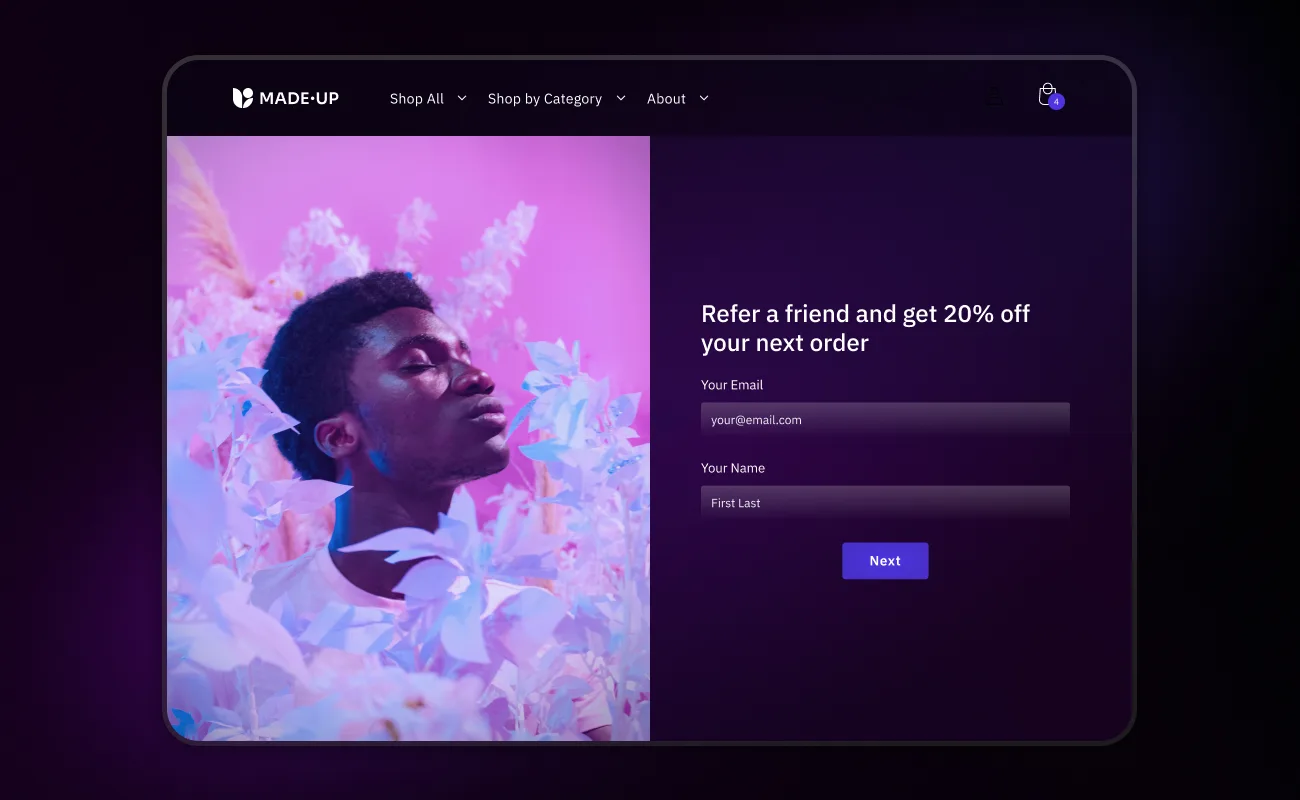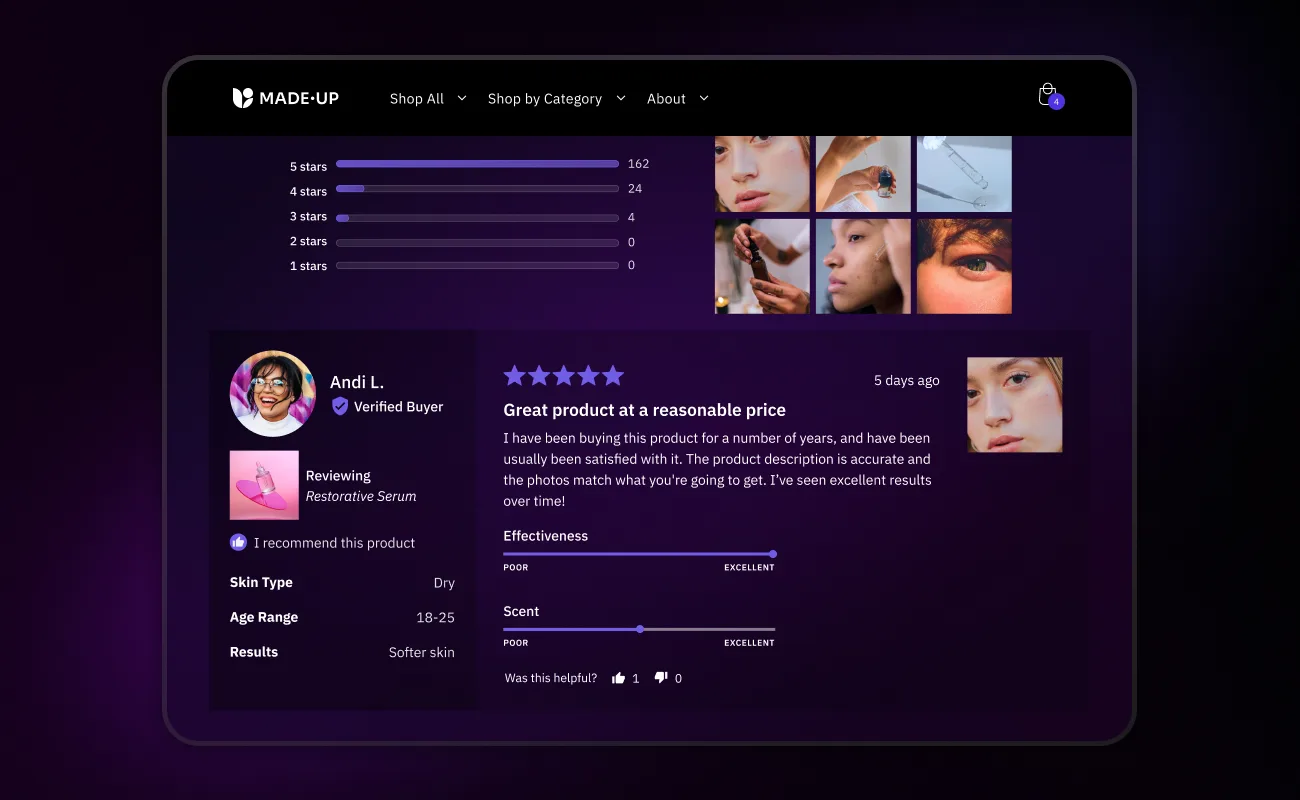
- Customer Marketing
- Reviews and UGC
- Social Proof
How To Add Social Proof on Shopify
Katie Vaught | Apr 25, 2025
Apr 23, 2024 | 12 minute read

Megan Wenzl
Content Marketing Manager
Even if you’re relatively new to ecommerce, you’ve witnessed the world of ecommerce experience meteoric growth and decades’ worth of advancement in a matter of years. Thanks to the development of AI, machine learning, macro-environmental factors, and new delivery and fulfillment formats, customer acquisition has become more streamlined—but also more expensive—for brands.
But now that the growth has tapered off and sales have slowed, ecommerce brands (and their stakeholders) like yourself are left wondering how you can compete with unprecedented times. Even if this year started with less-than-ideal sales, with the right growth strategies, you and your brand can make the most out of the rest of 2025.
We rounded up our top 12 ecommerce growth strategies to maximize sales and maintain the same level of growth from the past few years to make 2025 another one for the books.
In the fast-changing ecommerce landscape, brands must identify competitive advantages and implement growth strategies to continuously thrive. Put simply, if an ecommerce brand isn’t moving quickly, it might never move at all.
As competition intensifies, ecommerce brands must retain new machine learning, algorithms, and data science tools in their tech stacks to automate and keep up with the changing times. These advancements add even more pressure on ecommerce brands to keep up and be at the forefront of new technology waves before it’s too late and the competition takes market share. Reliable and tested growth strategies are necessary to maintain agility in this fiercely competitive market.
These 12 ecommerce growth strategies explain effective and easy ways to increase revenue and keep up with the competition. While some of these strategies explain additional actions that can be taken for incremental sales growth, others identify ways to optimize pre-existing strategies that might already be in your ecommerce toolkit. Read on to find where your brand has room to incorporate these strategies for continued and sustainable growth.
Referral marketing is also understood as word-of-mouth style marketing. It refers to the practice of using customer or affiliate referrals to acquire new customers or increase brand awareness.

Taking advantage of referral marketing can be tricky. After all, how can brands systematize a form of marketing that is meant to be organic and authentic? One way you (as a brand) can encourage or incentivize referral marketing is with “give one, get one” promotions in your own referral program. With this format, you offer exclusive discounts to existing and loyal customers and to a friend whom they would be referring to the brand. In this example, all three parties benefit—the referrer, the referee, and you (the brand).
Search engine optimization (SEO) can seem nebulous, but before you throw your hands up, first consider the value of an effective ecommerce strategy focused on SEO. Customers who input a search term into a major search engine on their mobile device or desktop are telling us two very important things:
SEO customers in ecommerce are the equivalent of customers in-store telling sales representatives exactly what they are looking for. They are already doing half the work. As a brand, you simply need to show them where to look.
An effective SEO strategy can aid your growth by matching qualified buyers with your assortment, thereby increasing the conversion rate and reducing the cost per acquisition. Since these customers are already high-intent, they are much more likely to purchase if your assortment is relevant to their query. SEO also represents a gateway into new markets and a fair chance to reach customers on a somewhat level playing field.
A strong social media presence has similar benefits to referral marketing—they both add authenticity and trustworthiness to your marketing efforts. Plus, they both have the opportunity for virality which can result in unprecedented results within sales channels.
Additionally, a strong social media strategy and presence extends beyond a consistent posting schedule and influencer marketing. Take a comprehensive approach and ensure your brand has strategies in place for all major social media platforms. This includes managing direct messages, giveaways and sweepstakes, posting options (video, stories, static posts), and influencer partnerships.

Consider creating a brand ambassador program to create a league of influencer partnerships, and lookout for social media content from your customer base that could be repurposed and leveraged as part of a campaign featuring customer testimonials.
The customers who use SEO during their shopping experience are, in a way, similar to the customers who utilize the live chat feature on an ecommerce site—they are qualified, high-intent shoppers. For these customers, it makes sense to pull out all the stops. Not only are they providing valuable customer insights and qualitative data regarding customer expectations, but they are also helping you help them. Investing in and giving extra attention to customers who use live chat features increases your site’s overall conversion rate, user engagement, and revenue.
When creating a live chat strategy, ensure the live chat personnel (whether artificial intelligence or human) is properly trained or set up to include upselling in their communications strategy. Routinely increasing the AOV of just a few orders can have drastic revenue growth implications for your brand.
Automation is an ecommerce luxury that is often unavailable in most brick-and-mortar store processes. Creating automated processes and limiting manual systems helps to conserve resources, save time, and oftentimes create better customer relationships.
While it can be tempting to automate most if not all processes for an ecommerce brand, understand that some aspects of the operation require a white-glove approach and human intervention. Small tasks like tagging, merchandising, or recapping can likely be automated with sporadic quality assurance audits.
By automating these processes, your brand can free up brand bandwidth to build growth strategies, implement CRO (conversion rate optimization) tactics, or plan for key initiatives that will help the brand stay ahead of the curve for continued growth.
Reviews are an effective way to add transparency and quantify the popularity of your product. The presence of reviews on a product detail page (PDP) creates a high level of trust and customer loyalty. And yes, this includes negative reviews.
To fully leverage reviews, ensure that your review program includes a rating system, visual cues like a fit indicator where appropriate, relevant product and customer attributes (size ordered, height for apparel, skin type for cosmetics, physical activity for sports equipment, etc.), and the ability to add media such as images or videos. This is made a lot easier by using a quality customer review platform.

The goal is to give potential or future customers a comprehensive view of the product they are considering in order for them to make an informed decision, increase conversion rate, and reduce high-cost returns.
Social proof and reviews go hand-in-hand. Social proof marketing is the practice of using customer testimonials or even behavior to influence future or potential customers into making a purchase.
Customer reviews and user-generated content (UGC) are effective and high converting, but they are often seen in lower funnel, research areas of the site (such as PDPs). Social proof operates under the premise that if we move the high-converting, valuable content further up the funnel, it can be used to acquire customers and create incremental growth. Incorporate reviews, customer testimonials and UGC in your social campaigns, display ads, or lifecycle marketing campaigns for doses of highly effective, low-effort conversions.
Personalization throughout the customer journey can effectively increase conversion rates by helping your customer base find products more efficiently thereby reducing shopping cart abandonment rates. A personalization strategy should be subtle and well-incorporated throughout the consumer decision-making process.
Instead of brandishing personalization efforts and creating uneasiness or privacy concerns, simplicity and small personalized adjustments can create a tailored and customer-focused experience. Consider marketing campaigns as well as onsite content and identify areas where personalization would be effective.
Implementing product recommendation quizzes, or segmenting audiences for email campaigns to be more targeted can profoundly impact conversion rates and overall magnetism of the online store shopping journey.
Email marketing is an inherently personable and targeted form of marketing. Through email newsletters, you can reach customers directly in their inboxes and even create behavioral-based, personalized email campaigns like browse or cart abandonment to increase customer loyalty.
Leverage email marketing in your growth strategies by combining some of the approaches above. Email is the perfect marketing channel for personalization, automation, and social proof. Consider creating dynamic content in emails to tailor the message to each customer or customer segment.
Incorporate automation processes where appropriate with trigger email campaigns or to simplify standard email cadences (order confirmation, subscriber welcome emails, etc.). Use social proof, customer reviews, or user-generated content to repurpose lower-funnel content and enhance the effectiveness of your email marketing campaigns.
With CPA costs rising and ecommerce becoming more competitive and saturated, focusing on conversion rate optimization is key to maintaining growth. The time, resources, and investment in acquiring new customers and driving traffic to your site could be rendered useless without CRO strategies. If a customer lands on your site, but the load times are sluggish, the UX is glitchy, the customer experience is subpar, and the customer ultimately bounces, the advertising spend to get that customer to the site will have been a waste.
Before making a significant investment in an acquisition campaign, perform an audit of the customer experience from start to finish. Ensure major pain points are resolved, the UX functions properly, and the overall experience is designed to entice the target audience. A few preemptive measures will aid in reducing costs while allowing for sales growth potential.
In the queues of site improvements, personalization strategies, and optimization projects, product photography is often at the end of the list of priorities. Why? Because photography is costly, time-consuming, and one of the few manual processes with very few options for automation available.
Still, limited product photography is one of the greatest deterrents to purchase. How can a customer purchase an item if they can’t see it in person or understand its material, relative size, and functionality? Having sufficient product photography can make or break the effectiveness of a PDP.
Robust product photography can include multiple angles highlighting key product features, special features shown in action, virtual try-ons, detail or material shots, and even 3D images or relative size scales. Understand that ecommerce customers are purchasing without being able to see, touch, and feel your products. Ensure your product imagery and overall content creation is thoughtful and adds value to the PDP to increase comfort levels, reduce hesitation, and increase conversion.
Since the nature of ecommerce encourages self-service and independent shopping, the importance of customer service is often overlooked. But, like in brick-and-mortar stores, customer interaction in ecommerce is a cornerstone to success. It’s essential for building brand loyalty and retention.
Due to the increased risk of shopping online (poor fitting products, inaccurate information, returns, delayed gratification), websites naturally have a lower conversion rate than physical stores. To mitigate concerns, reduce hesitance, and boost conversion to rival that of in-person stores, form a well-trained customer service team and implement strong customer service policies and best practices. Highly trained customer service personnel with expert product knowledge can reduce the likelihood of returns, increase retention, upsell to increase AOV, and create a lasting impression for a healthier customer lifetime value and continued growth.
When evaluating your ecommerce growth strategies, think of KPIs (key performance indicators) as your vital signs. For growth, the focus KPIs should be conversion rate, average order value, and customer lifetime value.
Okendo offers a comprehensive suite of tools designed to help you maintain growth for your online brand. Our products give brands the ability to generate reviews with user-generated content, personalize experiences with actionable customer data, provide incentives with customer loyalty programs, and scale referral marketing for a 360-degree ecommerce growth strategy.
With the use of these tools in one consolidated customer marketing platform, Okendo can supplement your current growth marketing efforts to increase conversion, retain customers, create memorable customer experiences, and deliver sustainable results.
Ecommerce marketing strategies involve far more than throwing budget dollars at paid ad campaigns. For a comprehensive approach, consider various forms of growth marketing like utilizing referrals, social media channels, email marketing, reviews, and social proof as a resource for sustainable growth.
Before investing in any campaigns, audit and enhance CRO measures like live chat, customer service, product photography, and the on-site experience to ensure any investment in driving traffic is not going to waste. Book a demo with Okendo to see how we can help with your next campaign and enhance your strategies for long-term, sustainable growth.
Related articles
Ready to learn more?